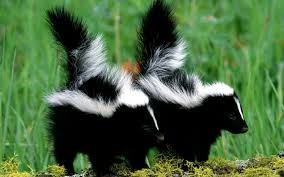The skunk perhaps attracts more interest than any other animal. The first thing that most people think when they hear ‘Skunk,’ is ‘Eew,’ and ‘Gross!’ But if you look closer into the life of a skunk, you will realize they are not as dangerous as they are said to be. What makes the skunk so very special?
Just about every animal possesses scent glands. They use them to mark their territory. For example, when a cat rubs it’s neck up against you, it is rubbing it’s scent glands off on you, marking you as it’s territory. Some animals, like otters, use their scent glands to condition and waterproof their fur. Other animals, like skunks, use their scent glands in a completely different way: their ultimate defense mechanism. Even though skunks get terrible reputation from humans who have had a bad encounter with them, skunk usually only spray as a last resort. After all, it’s spray is limited, and the skunk needs to save it for emergencies. It’s first line of defense is to walk away.
Most experienced predators will leave the skunk alone, remembering their first fight with one. If an animal or foolish human insists on taking a closer look, the skunks second line of defense is twisting it’s body, puffs up its tail to make itself look bigger, and stamps it’s front paws. If this attempt to scare away it’s stalker does not succeed, it will point it’s rear end at the threat and hold it’s tail high. Most times this will do the trick. But one particular species, the diminutive spotted skunk, goes one step further. To make itself look larger and more intimidating, it will do a hand-stand on it’s front paws, tail in the air, and hind legs spread apart. Even though this position is moore likely to make us laugh than to scare us, animals and humans alike would do well to heed the warning. Because the next step is to spray.
Skunks are very much aware of their power and even have to ability to control their weapon with great accuracy. They aim for the eyes of their target if they can see them, and spray. If they can not see their pursuer, they spray in a vapor, leaving a disgusting cloud for the predator to walk through. Skunks are cute, playful, and powerful. Skunks are totally amazing!



